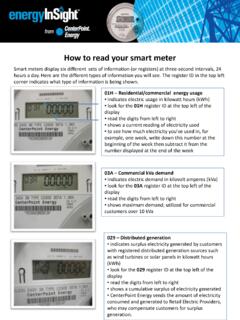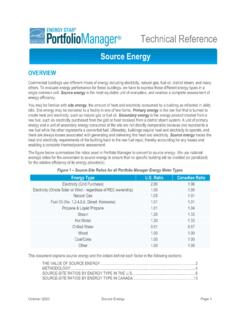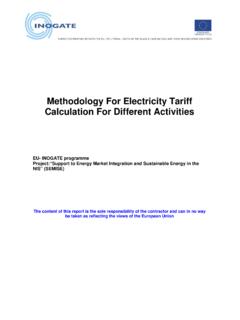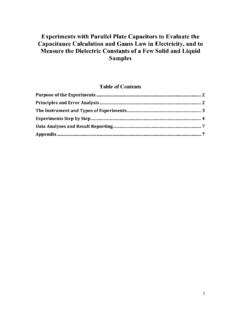Transcription of Radio Waves and the Electromagnetic Spectrum
1 Radio Waves and theElectromagnetic SpectrumLesson #4 Radio JOVE Educational MaterialsOctober 2001 Plan: Radio Waves and the Electromagnetic SpectrumObjective: Understand Radio Waves and how they relate to the electromagneticspectrum. Determine wavelength, frequency, and speed of Radio Waves . Master theseconcepts by completing example Standards:1. Content Standard B: Motion and Forces, Structures and Properties of Matter2. Content Standard D: Energy in the Earth SystemCourse/Grade level: Earth/Space Science Course, Physics Grade level: 9-12 Materials:1. Reference material with sample problems2. Student handout page with questions and problems3. Resource page on scientific notation and standard formEstimated Time: 30 - 45 minutesProcedure:1. Engagement: Introduction of the activityA. Ask the students to identify where on the Electromagnetic spectrumradio Waves are Ask the students to identify as many possible types of electromagneticwaves that they can.
2 Can the students identify common uses ofvarious wave types?C. Discussion of scientific notation may be needed; the included resourcepages can be used as a guided Exploration: Have the students read the reference material, stopping todiscuss parts as Explanation: Work through the example problems with the students, thenhave the students complete the questions on the student Extension: Upon completion of the student questions, discuss any additionalquestions that the students might have derived from the reading, pulling outinferences that they might have made about the relationship betweenwavelength and Evaluation: Additional questions to assess the students understanding of theconcepts of the JOVE Educational MaterialsOctober 2001 Page 1 Possible ideas from the engagement activities:A. Ask the students to identify where on the Electromagnetic Spectrum radiowaves are located Radio Waves are located at one end of the Electromagnetic Spectrum . Near microwaves.
3 Have the longest Ask the students to identify as many possible types of Electromagneticwaves that they can. Can the students identify common uses of various wavetypes? Microwaves and their use cooking and heating food. Infrared Waves for heat lamps. Ultraviolet Waves and their relationship to sunburn and skin cancer. X-rays and their use in hospitals. Gamma Rays for nuclear Discussion of scientific notation may be needed; the included resourcepages can be used as a guided practice. Review of Scientific Notation and Standard Form, tools for using largenumbers (see Resource Page).Problems and Answers1. Find the wavelength of a Radio wave with a frequency of 650 x 102 m (460 m)2. Find the wavelength of a Radio wave with a frequency of 1300 x 102 m (230 m)3. Find the wavelength of a Radio wave with a frequency of 90 MHz. m4. Find the wavelength of a Radio wave with a frequency of MHz. m5. AM Radio stations have frequencies from 540-1700 ) Find the shortest wavelength AM Radio signal.
4 X 102 m (176 m)b) Find the longest wavelength AM Radio signal. x 102 m (556 m)6. FM Radio stations have frequencies from 88-108 ) Find the longest wavelength FM Radio signal. mb) Find the shortest wavelength FM Radio signal. mThe frequency range of Jupiter Radio emissions that can be detected on Earth isapproximately 8 MHz to 40 Find the shortest wavelength Jupiter Radio wave that can be detected on m8. Find the longest wavelength Jupiter Radio wave that can be detected on m9. Find the wavelength of the Jupiter Radio wave that has a frequency of Explain the relationship between the wavelength and the frequency of theelectromagnetic Spectrum . Wavelength and frequency have an inverserelationship, meaning that as the frequency increases, the wavelength decreases,and vice JOVE Educational MaterialsOctober 2001 4-4 Teacher Page 2 ANSWER KEYQuiz Name_____Answer each question If you double the frequency of a wave, what happens to the wavelengthof the wave?
5 Answer: Wavelength is one-half (1/2) its original value because frequencyand wavelength are inversely proportional (f ~ 1/ ).2. What is the frequency of a citizen s band (CB) Radio which hasa wavelength of meters ?Answer: 26 MHz. (Use c = f)3. What is the wavelength of electricity (power Waves for buildings,lights, etc.)? The frequency of electrical Waves is 60 : x 106 meters or 5000 km!!! (Note: the velocity of the wave is NOT the same thing as the current in a wire; current travels much, much slower.) Radio JOVE Educational MaterialsOctober 2001 PageIn scientific notation, powers of ten are used to represent the zeroes in large following table shows how this is of ten1 one10010 ten101100 hundred1021,000 thousand10310,000 ten thousand104100,000 hundred thousand1051,000,000 million10610,000,000 ten million107100,000,000 hundred million1081,000,000,000 billion109If you examine the first and last columns, you can see that the power of ten is the same asthe number of zeroes in the number.
6 So the speed of light, which is 3 followed by 8zeroes, becomes 3 x 108 meters per in these activities, we will be working with large numbers that have several non-zero digits. In this case, the power of ten indicates how many places to move the decimalto the right rather than the number of zeroes to add. We will also round off the values sothat there are only three nonzero digits with one digit to the left of the decimal. This iscalled standard 1: 54311103 km becomes x 107 kmExample 2: 923 million dollars becomes 923 x 106 dollars. In standard form = x 108 dollarsExample 3: 3,478 seconds becomes x 103 seconds. (Remember to round the numbers if necessary)Example 4: Approximate number of stars in the Milky Way galaxy: 3 x 1011 can write this as: 300 x 109 stars( non standard form) or 300 billionstars, then as 300,000,000,000 stars.[Now do you see why scientific notation is so convenient?] Radio JOVE Educational MaterialsOctober 2001 (Intentionally blank.)
7 Radio JOVE Educational MaterialsOctober 2001 and Frequency of Radio WavesRadio Waves are one part of the complete Electromagnetic Spectrum . As you can see fromthe figure below, there are many different types of Waves and these Waves are differentbecause they have different property to compare different kinds of Waves is called the wavelength, or length of awave. Wavelength is defined as the distance from one point on a wave to thecorresponding point on the next wave. Since wavelength is a distance, the unit ofwavelength is the meter (m). Radio Waves have the longest wavelength compared to othertypes of Waves (see figure).Another property used to compare Waves is the frequency of a wave, which is defined asthe number of Waves created per second. As the Waves propagate away from the source,the frequency also represents the number of Waves that will pass a point per second. Theunit of frequency is one divided by time (1/seconds) and scientists have given thisfrequency unit the name of hertz (Hz).
8 Radio Waves have the lowest frequency comparedto other types of Waves . On your Radio receivers, either in your car or at your home, theunit of measurement is also in Hz, but usually in one of two variations, kHz and MHz(kilohertz, thousands of hertz and megahertz, millions of Hertz respectively). Thesevariations are used to help identify the length of the wave, by using simple speed of a wave can be measured, and what scientists have discovered is that thespeed of all types of Electromagnetic Waves is the same. Scientists call this speed thespeed of light because visible light is the most familiar kind of wave to humans [that iswhat we see!]. The speed of light is measured to be 300,000,000 m/s, which can also bewritten as, 3 x 108 m/s (approximately 186,000 miles per second!). Radio WavesNote: the units of measurement for wavelength in the diagram is centimeters(cm)Image credit: JOVE Educational MaterialsOctober 2001 , wavelength and speed are related by the equation:c = fwherec is the speed of light (3 x 108 m/s), (lambda) is the wavelength in meters (m),andf is the frequency in Hertz (Hz).
9 From this equation we can see that a long wavelength will have a low frequency while ashort wavelength will have a high frequency since the product of these two quantities isconstant (that is, the product equals the speed of light).Example problem:Find the wavelength of a Radio wave with a frequency of 900 = 900 kHz = 900 x 103 Hz = 9 x 105 Hzc = 3 x 108 m/s = ? c = f (Solve for )In this diagram, the distance (d) indicated represents the distance the Waves travel in #1 has 5 complete Waves passing by in one second, while Wave #2 has 10waves passing by in the same time. If you were to watch Wave #1 pass a point, thefrequency would be 5 Waves per second or 5 Hz. Wave #2 would have a frequency of10 hertz. Wave #1 has half the frequency of Wave #2 and two times the both Waves , the product of the wavelength and frequency are the (distance traveled in 1 second)#1#2 1 24. = .33 x 103 = x 102 m (330 m)3 x 108 m/s9 x 105 Hz3. =cf2.
10 =c = JOVE Educational MaterialsOctober 2001 Student PageName_____Date_____ProblemsAnswer each of the following questions. Be sure to show all work needed in thecalculations and include the units in the answer1. Find the wavelength of a Radio wave with a frequency of 650 Find the wavelength of a Radio wave with a frequency of 1300 Find the wavelength of a Radio wave with a frequency of 90 Find the wavelength of a Radio wave with a frequency of AM Radio stations have frequencies from 540-1700 Find the shortest wavelength AM Radio Find the longest wavelength AM Radio FM Radio stations have frequencies from 88-108 Find the longest wavelength FM Radio Find the shortest wavelength FM Radio frequency range of Jupiter Radio emissions that can be detected on Earth is 8 MHz to 40 Find the shortest wavelength Jupiter Radio wave that can be detected on Find the longest wavelength Jupiter Radio wave that can be detected on Find the wavelength of the Jupiter Radio wave that has a frequency of Explain the relationship between the wavelength and the frequency of theelectromagnetic JOVE Educational MaterialsOctober 2001









